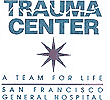Zuckerberg San Francisco General Hospital and Trauma Center
What Trauma Is Trauma is accidental or intentional physical injury caused by events such as motor-vehicle crashes, falls, explosions, shootings, or stabbings. It occurs without warning and can happen to anyone. Unintentional injury is the 5th leading cause of death among all ages in the United States. Thus, it is likely that in your lifetime, either you or someone very close to you, will sustain a traumatic injury. Although traumatic injuries occur at all ages, the typical victim is young, healthy, and enjoying the most productive years of his/her life.
An Emergency Department has a broad scope of practice treating heart attacks, chest pain, asthma, minor cuts, sprains, allergic reactions, gastrointestinal bleeding. It is a single-specialty department characterized by on-site hospital based procedures, principal referral service with short duration follow-up, but no major operative procedures or ICU. After a decision is made to admit the person to the hospital, ED transfers the patient to another service. In the case of the severely injured patient, the transfer is usually to the Trauma Service. A Trauma Center has a focused scope of practice including general surgery, neurosurgery, and orthopedic services. It has multiple specialties characterized by hospital-based and outpatient practice, rapid or immediate response to major injury patients, admitting services with long-term follow-up, admitting performance of major operative procedures, and post-admission critical care. Trauma Care follows a progression that usually includes: pre-hospital care, resuscitation, operative care, critical care, acute recovery, discharge planning & rehabilitation, long-term follow-up, and functional recovery. What is the difference between a Level I, II, III, IV Trauma Center? The four levels refer to the kinds of resources available in a trauma center and the number of patients admitted yearly. These are categories that define national standards for trauma care in hospitals. The American College of Surgeons developed and continues to recommended the standards and the California State Trauma Care Systems uses the levels in its regulations.
What is a Trauma System? A Trauma System is an inclusive, regionalizaed coordinated effort organized to delivery the full range of care to all injured patients. Trauma systems are integrated within the local EMS system. Injury Data for the City and County of San Francisco, 2001 The following data is from the California Department of Health Services, EPIC branch and includes injuries treated at San Francisco General Hospital and other hospitals in the San Francisco. Five Leading Causes of Fatal Injuries in the City and County of San Francisco, 2001
Prepared by California Department of Health Services, EPIC Branch Five Leading Causes of Hospitalized Nonfatal Injuries in the City and County of San Francisco, 2001
Prepared by California Department of Health Services, EPIC Branch Please call 9-1-1 if this is a medical emergency. Please call Zuckerberg San Francisco General Hospital and Trauma Centerl at (628) 206-8000 for general information.
|


 The Level I Trauma Program
The Level I Trauma Program What is the difference between a Trauma Center and an Emergency Department?
What is the difference between a Trauma Center and an Emergency Department?